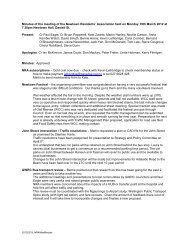Draft Town Belt Management Plan - Wellington City Council
Draft Town Belt Management Plan - Wellington City Council
Draft Town Belt Management Plan - Wellington City Council
You also want an ePaper? Increase the reach of your titles
YUMPU automatically turns print PDFs into web optimized ePapers that Google loves.
Appendix 3 <strong>Town</strong> <strong>Belt</strong> traditional history<br />
Morrie Love<br />
Pictorial Illustrations of New Zealand, S C Brees, Principal Engineer to the New<br />
Zealand Company, London 1847, showing Mt Alfred in background right.<br />
The history and traditions related to the places that now make up the <strong>Town</strong> <strong>Belt</strong> go back to the<br />
earliest arrival of Māori in <strong>Wellington</strong>. That time was arguably 850 AD but perhaps nearer 1200<br />
AD. Two important components of the <strong>Town</strong> <strong>Belt</strong> are the key ridgelines in the east and west of<br />
central <strong>Wellington</strong>, known as Te Ranga a Hiwi – or the ridge of Hiwi – and the ridgeline of<br />
Ahumairangi. Hiwi was the son of the daughter of Tara, the eponymous ancestor of Ngāi Tara. Ngāi<br />
Tara were probably the first Māori to settle the area, constructing pā and developing gardens and<br />
using the forests to gather food. Before Ngāi Tara were others, more of the hunter-gatherer groups<br />
known by some as the kahui tipua, who moved around taking advantage of the natural resources of<br />
the region.<br />
Before them was the time of the taniwha, the most famous being the two in the harbour of Ngāke<br />
and Whataitai. In their time the harbour was a lake blocked from the ocean and Ngāke wanted to<br />
escape to the open ocean. He crashed out to form the channel known as Te Au a Tane, the present<br />
channel into <strong>Wellington</strong> harbour. When Whataitai tried to follow suit through the area where<br />
Kilbirnie now is, however he failed and became stranded and instead the area uplifted leaving<br />
Whataitai high and dry. He then transformed into a manuwairua called Te Keo or a spirit bird. Te<br />
Keo alighted on the lesser peak next to Matairangi/Mt Victoria. This lesser peak became known as<br />
Tangi Te Keo or the cry of Keo. Before the taniwha, the North Island was Te Ika a Maui or Maui’s<br />
fish pulled up from the ocean from the South Island, Te Waka a Maui.<br />
Ngāi Tara built a series of pā, the largest being the Akatarewa Pā, on the <strong>Town</strong> <strong>Belt</strong> around<br />
<strong>Wellington</strong> College and extending up to the ridgeline. The Basin Reserve was the mahinga kai<br />
(access to food and resources) called Hauwai, where the eels and other fish from the swamp<br />
streams were gathered. The earliest gardens made by Māori simply involved clearing of the forest<br />
and allowing the regrowth of ferns as happens after a fire in forest. The bracken ferns have edible<br />
roots which Māori called aruhe. The terracing of the hills allowed the growth of the tropical<br />
kumara or sweet potato. Later potatoes, melons and corn were planted in gardens where land was<br />
<strong>Draft</strong> <strong>Town</strong> <strong>Belt</strong> <strong>Management</strong> <strong>Plan</strong> October 2012 193





